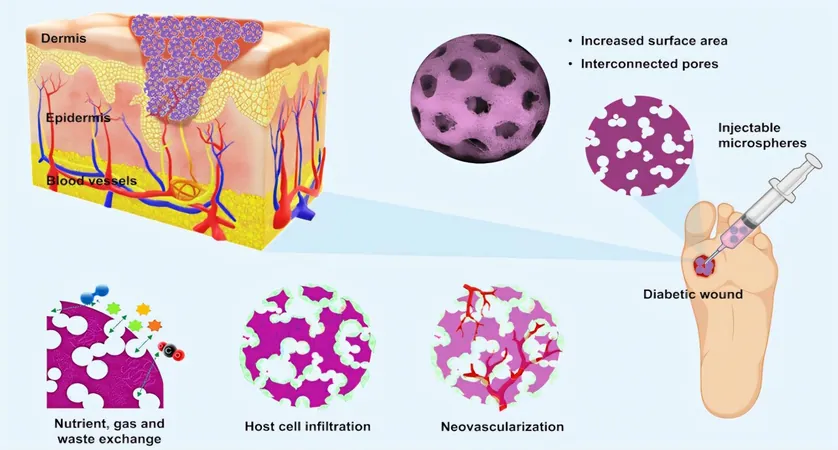
Breakthrough in Diabetic Wound Treatment: Injectable Nanofibrous Microspheres Could Be Game-Changer!
2024-10-31
Author: Wei
Introduction
In a remarkable advancement for diabetic wound care, researchers at the Terasaki Institute for Biomedical Innovation (TIBI) have unveiled an innovative injectable granular filler that may revolutionize treatment protocols and enhance patient outcomes. This pioneering study, published in the prestigious journal ACS Nano, showcases cutting-edge porous dermal fillers specifically engineered to expedite tissue healing and regeneration.
Research Collaboration
Collaborating with specialists from the University of Nebraska Medical Center (UNMC), the TIBI research team harnessed advanced manufacturing techniques, including electrospinning and electrospraying, to fabricate porous, granular nanofibrous microspheres (NMs). Composed of biocompatible materials like poly(lactic-co-glycolic acid) (PLGA) and gelatin, these microspheres allow for a minimally invasive injection directly into wound sites, thus transforming the traditional treatment landscape for diabetic ulcers.
Significance of the Technology
"This technology signifies a monumental leap in wound care, marking a turning point for the millions affected by diabetes worldwide," proclaimed Dr. Johnson John, the study’s lead investigator. "Our approach not only minimizes invasiveness but also promises to enhance healing outcomes significantly and swiftly, a crucial factor for patients enduring prolonged recovery times."
Advancements in Wound Healing Mechanics
The research highlights several critical advancements in wound healing mechanics. The specially designed dermal fillers, featuring adjustable porous microstructures, exhibited impressive capabilities in promoting cell migration, granulation tissue formation, and neovascularization—the creation of new blood vessels. Remarkably, these fillers maintain structural integrity during the injection process, further solidifying their practical application potential.
Clinical Significance
Dr. Ali Khademhosseini, CEO of TIBI, emphasized the clinical significance of this innovation. "This approach to diabetic foot ulcers embodies the kind of transformative technology that modern healthcare desperately requires. By merging sophisticated biomaterial science with real-world applicability, we pave the way for enhanced treatment options for millions of diabetes sufferers dealing with chronic wounds."
Implications for Wound Healing
The implications of this research extend beyond mere technology; it showcases substantial promise in refining three essential elements of wound healing: the infiltration of host cells, the regeneration of skin tissue, and improved vascularization. These breakthroughs imply a potential reduction in the necessity for invasive surgical procedures while simultaneously elevating patients' quality of life.
Future Directions
As the research team gears up for further studies aimed at advancing this technology toward clinical trials, the prospect of new, effective treatments for diabetic wounds is not just a hopeful dream but a tangible reality on the horizon. Are we on the verge of changing the lives of millions struggling with diabetic wounds? Only time will tell!



 Brasil (PT)
Brasil (PT)
 Canada (EN)
Canada (EN)
 Chile (ES)
Chile (ES)
 España (ES)
España (ES)
 France (FR)
France (FR)
 Hong Kong (EN)
Hong Kong (EN)
 Italia (IT)
Italia (IT)
 日本 (JA)
日本 (JA)
 Magyarország (HU)
Magyarország (HU)
 Norge (NO)
Norge (NO)
 Polska (PL)
Polska (PL)
 Schweiz (DE)
Schweiz (DE)
 Singapore (EN)
Singapore (EN)
 Sverige (SV)
Sverige (SV)
 Suomi (FI)
Suomi (FI)
 Türkiye (TR)
Türkiye (TR)